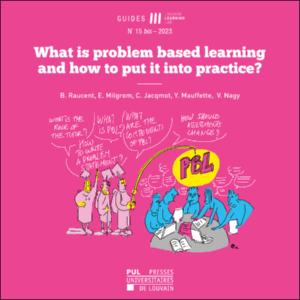Please use this identifier to cite or link to this item:
http://hdl.handle.net/20.500.12279/1071
Full metadata record
| DC Field | Value | Language |
|---|---|---|
| dc.contributor.author | RAUCENT, Benoît | - |
| dc.contributor.author | MILGROM, Elie | - |
| dc.contributor.author | JACQMOT, Christine | - |
| dc.contributor.author | MAUFFETTE, Yves | - |
| dc.contributor.author | NAGY, Viktoria | - |
| dc.date.accessioned | 2024-06-04T13:48:02Z | - |
| dc.date.available | 2024-06-04T13:48:02Z | - |
| dc.date.issued | 2023 | - |
| dc.identifier.isbn | 978-2-39061-366-4 (version numérique) | - |
| dc.identifier.isbn | 978-2-39061-365-7 | - |
| dc.identifier.uri | http://hdl.handle.net/20.500.12279/1071 | - |
| dc.description.abstract | Our world has significantly changed over the past decades, and this has changed students’ motivation and their expectations concerning the training received at university. Can we still teach the way we were taught ourselves? The answer to that question lies in what awaits students after leaving university: their success will depend on their capacity to adapt to the requirements of their professional environment and to an ever-changing world. To do so, they need to become lifelong learners and master transferable skills such as critical thinking, problem-solving, communication, teamwork, information literacy etc. in addition to disciplinary knowledge and professional know-how. Can such goals be achieved by means of traditional pedagogy mostly based on the transmission of knowledge by teachers? We strongly believe that a radical pedagogical change is necessary to move away from teaching- (and teacher-) centered approaches to learning- (and student-) centered approaches. One of these approaches is Problem Based Learning (PBL). This booklet is a simple guide to the PBL methodology and its implementation. Rather than being a comprehensive review of the abundant literature on the topic, the booklet aims to provide a practical, easy-to-read and playful introduction for those who would like to experiment with PBL in their curricula. To make the reading enjoyable, the information is presented synthetically, with numerous illustrative sketches. The objective with this booklet is not only to demystify PBL but also to spark your interest in “implementing change.” | en_US |
| dc.format | eBook | en_US |
| dc.language.iso | en | en_US |
| dc.publisher | Presses universitaires de Louvain | en_US |
| dc.rights | Attribution-ShareAlike 4.0 International | * |
| dc.rights.uri | http://creativecommons.org/licenses/by-sa/4.0/ | * |
| dc.subject | problem based learning | en_US |
| dc.subject | education | en_US |
| dc.subject | training | en_US |
| dc.subject | pedagogy | en_US |
| dc.subject | high quality education | en_US |
| dc.subject | motivation | en_US |
| dc.subject | changing world | en_US |
| dc.subject | lifelong learners | en_US |
| dc.subject | transferable skill | en_US |
| dc.title | LLL Guides - N°15 bis: What is problem based learning and how to put it into practice? | en_US |
| dc.type | Book | en_US |
| LOM.educational.typicalAgeRange | Longlife | en_US |
| LOM.educational.typicalAgeRange | Other | en_US |
| LOM.educational.typicalLearningTime | Other | en_US |
| LOM.educational.language | en | en_US |
| dc.audience | Teacher | en_US |
| Appears in Collections: | Faculty development | |
Files in This Item:
| File | Description | Size | Format | |
|---|---|---|---|---|
| CahierLLL_N15.pdf | 11.54 MB | Adobe PDF |  View/Open |
| This item is licensed under a Creative Commons License Attribution-ShareAlike 4.0 International (CC BY-SA 4.0) |

|
